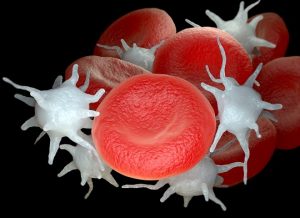
Congrats to Robert H Lee, Brinkhous Early Career Investigator Award winner at American Heart Association’s Vascular Discovery: From Genes to Medicine 2020! This year’s event was held virtually May 5-7. Dr. Lee’s work involved a study that yields insights on DAPT safety in thrombocytopenia & the best use of platelet transfusion for bleeding reversal.
 “Evaluating the Impact of Thrombocytopenia and Platelet Transfusion on Bleeding and Thrombosis in the Setting of Anti-Platelet Therapy.” RESULTS: Study informs about DAPT safety in thrombocytopenia and best use of platelet transfusion for bleeding reversal.
“Evaluating the Impact of Thrombocytopenia and Platelet Transfusion on Bleeding and Thrombosis in the Setting of Anti-Platelet Therapy.” RESULTS: Study informs about DAPT safety in thrombocytopenia and best use of platelet transfusion for bleeding reversal.
Authors
Robert H Lee, David S Paul, Wolfgang Bergmeier, Univ of North Carolina, Chapel Hill, NC
Abstract
Platelet transfusion is an effective hemostatic therapy in thrombocytopenic patients, but its utility in the treatment of platelet function disorders (PFDs) is less clear. For example, several clinical reports described ineffective platelet transfusion therapy in patients with Glanzmann’s Thrombasthenia (GT) or with mutations in RASGRP2, encoding for the platelet signaling protein CalDAG-GEFI. To investigate this phenomenon, we studied hemostatic plug formation with real-time imaging in murine PFD models. These studies demonstrated that dysfunctional platelets (1) compete with normal platelets for early binding to von Willebrand factor, and (2) affect clot composition by disrupting platelet-platelet cohesion during plug formation. Interestingly, similar effects were observed in studies with inhibitor-treated platelets. Building on these findings, we are currently investigating two questions related to the use of dual anti-platelet therapy (DAPT) in patients: first, is there an optimal post-transfusion ratio in the setting of DAPT that is pro-hemostatic but does not lead to an increased thrombotic risk, and second, is there a threshold platelet count where DAPT causes severe bleeding? The hemostatic function of transfused platelets is evaluated in mice using a large injury (saphenous vein needle injury) and a small injury (saphenous vein laser injury) model. The needle injury model is ideal to test the pro-hemostatic function of transfused platelets as DAPT-treated mice are unable to achieve hemostasis in this model. Additionally, transfusion ratios with a significant hemostatic impact will be tested in a thrombosis model to determine whether transfused platelets can also restore thrombosis. In contrast, DAPT-treated mice with normal platelet counts exhibited minimally prolonged bleeding times in the laser injury model. We observed that in mice with a platelet count < 5% of normal, DAPT treatment led to significantly prolonged bleeding with most injuries never achieving a hemostatic event, while untreated thrombocytopenic mice rapidly form a hemostatic plug. Together, these studies aim to improve our understanding of the safety of DAPT in thrombocytopenia, and how best to use platelet transfusion to reverse bleeding in these patients.
The Kenneth M. Brinkhous Early Career Investigator Prize in Thrombosis recognizes outstanding endeavors by new investigators in fundamental and applied research in Thrombosis including the mechanism, detection, treatment, and prevention of thrombotic disorders.
Past awardees include: Wolfgang Bergmeier. PhD in 2009.
